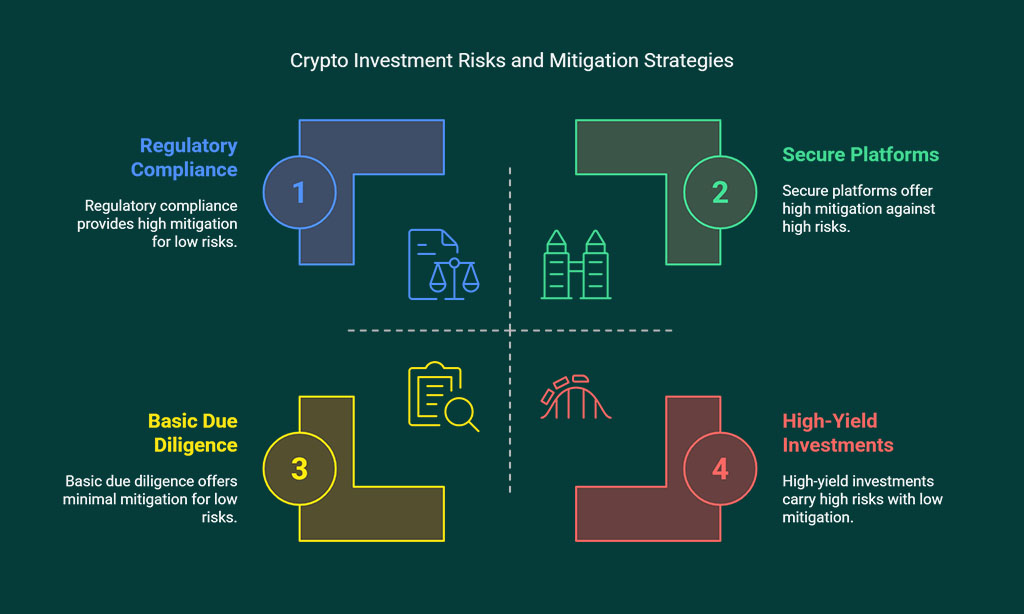Making extra money while you sleep sounds amazing, right? But with rising bills and unstable markets, many people feel stuck. Finding a reliable way to grow your money can seem tricky.
One growing option is earning passive income through cryptocurrency. By staking coins, joining liquidity pools, or lending crypto, you could earn steady rewards without much daily effort.
This guide breaks it down step by step.
Ready to learn how to make your crypto work for you? Keep reading!
Key Takeaways
- Staking crypto, like Ethereum at 3.2% APY or Solana at 7.1%, can earn steady rewards but may limit access to your funds during lock-up periods.
- Yield farming offers high returns using DeFi platforms but carries risks like impermanent loss and smart contract bugs; research is key before starting.
- Crypto lending on platforms like Coinbase (5% APY for USDC) can grow savings, but loan defaults or platform failures are major risks to watch out for.
- Play-to-earn games and dividend-paying tokens provide income options, but profits depend on market trends and token or NFT values over time.
- Diversify strategies across staking, lending, and liquidity pools while starting small to reduce risks from scams, volatility, or technical issues.
Popular Methods for Earning Passive Income Through Cryptocurrency
Crypto offers many ways to earn without constant effort, like earning interest or rewards. Picking the right method can boost your savings over time.
Staking
Staking locks your cryptocurrency to support blockchain networks. It helps secure the network and process transactions. In return, you earn rewards like an annual percentage yield (APY).
For example, staking Ethereum (ETH) can give 3.2% APY in Q1 2025, while Solana (SOL) offers 7.1%.
Staking requires holding tokens for a set time, which may limit liquidity. Factors like token value, lock-up periods, fees, and network performance impact earnings. Choose platforms with lower fees to increase profits and reduce risks tied to market volatility or technical issues on the blockchain system.
Yield Farming
Yield farming lets you earn rewards by lending or staking cryptocurrency. It works through decentralized finance (DeFi) protocols and uses smart contracts. These programs control the process without needing banks or brokers.
High annual percentage yields (APY) can make it attractive, but risks loom large.
Impermanent loss is a common risk in yield farming. This happens when crypto prices change while locked in a liquidity pool. Smart contract bugs also pose dangers, as hackers may exploit them to steal funds.
To lower risks, research platforms carefully and avoid putting all your tokens into one strategy.
Crypto Lending
Crypto lending platforms like BlockFi, Nexo, and Celsius let you earn interest by loaning your crypto. For example, Coinbase offers a 5% annual percentage yield (APY) on USDC savings accounts.
You deposit funds, and borrowers pay interest to use them.
This method comes with risks. Borrowers may fail to repay loans, or platforms may suffer liquidity issues. Decentralized finance (DeFi) protocols can reduce counterparty risk but rely on smart contracts that could have bugs.
Always check platform security and verify interest rates before investing your digital assets.
Liquidity Pools
Liquidity pools let people earn income by providing cryptocurrency to decentralized exchanges (DEXs). These pools power trades on platforms without middlemen. Users deposit their digital assets into these pools and earn trading fees in return.
For example, supplying USDT and ETH to a pool might yield rewards based on the platform’s annual percentage yield (APY).
The risk isn’t small. Impermanent loss can happen if token prices shift too much during your investment period. Managing liquidity can get tricky, especially with price fluctuations or low market sentiment.
But for some, steady rewards from DEX activity outweigh this downside. Always track your crypto portfolio and stay cautious of volatile markets when using DeFi protocols like Uniswap or PancakeSwap.
Dividend-Paying Tokens
Some crypto tokens pay dividends, just like stocks. Tokens such as KuCoin Shares (KCS) or NEO share profits from their projects with holders. The income depends on the platform’s performance and trading fees.
These tokens can provide consistent returns but come with risks. If the project fails or loses market value, investors might face losses. Market volatility also impacts earnings, making it crucial to assess risks before investing in dividend-paying crypto assets.
Advanced Strategies for Passive Crypto Income
These methods take more effort but can bring bigger rewards. They often need special tools or skills, like running a masternode or mining rigs.
Running a Masternode
Running a masternode can generate steady passive income. Masternodes support blockchain networks by processing transactions and securing data. They require a large initial deposit of cryptocurrency as collateral, such as 1,000 DASH for Dash nodes.
This helps keep the network honest by discouraging bad actors.
Setting up a masternode takes technical know-how and effort. You need a reliable server with high uptime, strong internet speed, and extra storage space to host the node. Rewards come in the form of staking rewards or block rewards paid in crypto tokens.
For example, some networks offer annual percentage yields (APY) ranging from 5% to over 20%.
Cloud Mining
Cloud mining lets you earn cryptocurrency without owning hardware. Companies rent their mining equipment and share profits with users. This method avoids high electricity costs and maintenance hassles that come with traditional bitcoin mining.
Fees can eat into your earnings, lowering profitability. Some platforms also trick users, so watch for scams. Research trusted services before starting to avoid risks. Stick to well-known providers with transparent terms to protect your investments.
NFT Staking and Royalties
NFT staking lets you earn passive income by locking NFTs on specific platforms. These platforms reward holders with tokens or extra perks. Your earnings depend on the NFT’s value and demand in decentralized finance (DeFi).
For example, rare digital art or gaming items can generate steady rewards if staked.
NFT royalties provide another income source for creators. Each time an NFT is sold, a small percentage is paid to its original maker. This system works through smart contracts and depends on market trends.
If popular collections like Bored Ape NFTs rise in value, their creators gain more from secondary sales.
Play-to-Earn Games
Play-to-earn games let players earn crypto by playing. Popular titles like Axie Infinity require buying NFTs first. These NFTs act as characters or tools in the game. Players win rewards in tokens, which can be traded for real money.
Time and effort matter here. Some tasks are simple; others take hours to complete. Earnings depend on game popularity and token value. Be cautious, though—prices for NFTs and tokens can drop quickly, adding risk to your investment strategy.
Choosing the Right Platform for Crypto Passive Income
Picking a crypto platform can feel like choosing the right tool for a big job, so weigh security, fees, and features to avoid costly mistakes.
Centralized vs. Decentralized Platforms
To earn passive income with crypto, choosing the right platform is critical. Understanding centralized and decentralized solutions helps you decide. Here’s a comparison:
| Feature | Centralized Platforms | Decentralized Platforms |
|---|---|---|
| Definition | Run by companies like Coinbase or BlockFi. Services are managed by a central authority. | Operates on blockchain technology. No central control, users interact with smart contracts. |
| Control | You hand over your crypto to the company. | You retain control of your funds. Wallets connect directly to the platform. |
| Knowledge Needed | Less technical skills required. User-friendly interfaces. | Requires DeFi knowledge. May involve complex tools like Aave or Uniswap. |
| Risks | If the company goes bankrupt, like BlockFi, you could lose funds. | Smart contract bugs or hacks can cause losses. |
| Security | Custodial. You rely on the platform’s security. | Non-custodial. Security depends on your wallet and contract quality. |
| Trust | Trust is placed in the company managing your funds. | Relies on blockchain transparency. Trustless system. |
| Fees | Fees may include deposit, withdrawal, and service charges. | Lower fees. Gas costs for transactions may apply. |
| Examples | Binance, Kraken, BlockFi. | Aave, Curve Finance, PancakeSwap. |
Evaluating Fees and Features
Picking the right platform for earning passive income in cryptocurrency is key. Many factors can affect your profits, so check fees and features carefully.
- Check trading fees. Platforms charge fees for buying, selling, or swapping digital assets. Even small fees can add up over time. Compare rates across different exchanges.
- Look at deposit and withdrawal fees. Some platforms require high charges to move coins in or out of wallets or accounts.
- Review annual percentage yield (APY). Staking rewards and crypto savings accounts offer varying APYs. A higher APY could mean bigger returns but might also carry added risks.
- Test platform security features. Use platforms with strong security keys, two-factor authentication, and proven systems against hacks or breaches.
- Study available defi protocols and tools like smart contracts. Decentralized finance platforms often have better flexibility but depend on reliable technology.
- Read about past user experiences to evaluate reputation and trustworthiness. Avoid any lending platforms with bad reviews or shady histories.
- Confirm token options available for staking or lending programs fit your portfolio goals without locking funds too long.
- Pay attention to liquidity pools if using decentralized exchanges (DEXs). These pools may impose impermanent loss if prices shift quickly on blockchains like Ethereum (ETH).
- Compare interest rates on centralized vs decentralized lending options to find what works best for your crypto investments.
- Focus on platforms with clear policies about tax implications and taxable events tied to lending rewards or dividend policies.
Always keep an eye on all possible expenses linked with mining cryptocurrency, staking rewards, or utilizing liquidity pools! Smart decisions here protect earnings from high costs eating them away bit by bit!
Security and Reputation
Security and reputation matter a lot in crypto platforms. Losing money to scams is common, so picking wisely can save headaches.
- Check if the platform has strong security measures like two-factor authentication (2FA) or cold storage for funds. These tools help protect your digital assets.
- Look for platforms with a long history and good reviews. New or unknown platforms might carry bigger risks.
- Avoid platforms with unclear or hidden fees. Transparent fee structures build trust.
- Verify if the platform complies with legal regulations in your country. This reduces risks tied to regulatory uncertainty.
- Be cautious of sites promising extremely high returns quickly. Pump-and-dump schemes and scams often use such tactics.
- Choose platforms that let you keep control of your keys through crypto wallets, like Trust Wallet or Ledger, for added safety.
- Research their customer support quality by checking user opinions online. Poor support could leave issues unresolved during emergencies.
- Platforms with frequent audits by third-party firms show they care about security and honesty.
- Ensure they’re not involved in infamous hacks or fraud cases from reports like the FBI’s 2023 warning on crypto-related scam losses increasing by 45%.
- Confirm they have an active community and solid partnerships with known entities in decentralized finance (DeFi). Solid backing adds credibility too!
Risks and Considerations
Crypto can be tricky, with its wild price swings and potential pitfalls. You need sharp eyes and careful steps to dodge trouble.
Market Volatility
Prices in crypto can swing wildly. Bitcoin has dropped over 50% in months before, wiping out billions. Such market volatility makes earning passive income risky. Values can rise sharply but also crash without warning.
This instability affects staking rewards and DeFi protocols like liquidity pools. A coin’s price drop could cause impermanent loss—where assets held are worth less than if you had simply kept them.
Secure platforms with trusted reputations help lower this risk slightly, but nothing is guaranteed in such a fast-moving market.
Scams and Fraudulent Platforms
Scammers use fake cryptocurrency exchanges and rug pulls to steal money. In 2023, fraud losses in crypto hit $5.6 billion. Rug pulls happen when fake projects trick investors, then vanish with funds.
Some scams copy trusted exchanges like Coinbase or Binance, making them hard to spot.
The FBI reported a 45% rise in scam losses that same year. Fraudulent platforms often promise high rewards but never pay out. Play-to-earn games and decentralized lending platforms can also be targets for fraudsters.
Always check platform security and avoid sites with unclear fees or shady terms.
Regulatory and Tax Implications
Crypto earnings like staking rewards, mining profits, and lending interest are taxable. The IRS treats these as income. For example, if you earn BTC through crypto mining, its value at the time earned is taxed as ordinary income.
Selling or trading digital assets can lead to capital gains taxes too. If you hold for less than a year before selling, it’s taxed at higher short-term rates.
Tax laws vary by country. In the U.S., filing mistakes can lead to fines or audits. Keep clear records of all crypto transactions—market buys, staking payouts, and yield farming returns included.
Watch out for scams; the FTC warns about fake platforms promising high APY but taking your funds instead!
Tips for Maximizing Earnings
Start small, test the waters, and grow your investments over time. Always research platforms, fees, and risks before committing your funds.
Diversify Your Strategies
Spread your investments across multiple passive income methods like staking, yield farming, and crypto lending. This reduces risk if one option underperforms. For example, market volatility can hit staking rewards hard, but liquidity pools might still generate steady returns.
Mixing centralized platforms with decentralized finance (DeFi) tools increases flexibility. Use trusted wallets and secure platforms with low trading fees to avoid scams or platform insolvency.
Diversification helps balance opportunities while managing risks better in a shifting market.
Start Small and Scale Gradually
Start with a small amount of cryptocurrency. Test staking or crypto lending on trusted platforms, like Coinbase. They offer 5% interest on USDC, making it beginner-friendly and low-risk.
Focus on learning how fees and rewards work.
Grow your investments slowly as you gain confidence. Avoid putting all your money in one method or token to reduce risks like market volatility or scams. Steady steps protect your digital assets while building real passive income over time.
Research Before Committing to a Method
Study every method before diving in. Staking might seem easy, but fees or platform insolvency could ruin earnings. Yield farming offers high returns, yet can expose you to impermanent loss if the market shifts fast.
Crypto lending may sound safe, but defaults happen. Look into platforms like Trust Wallet or decentralized exchanges for more secure options. Always check security features, APY rates, and platform history to avoid scams and fraud.
Takeaways
Passive income with cryptocurrency is possible and exciting. Staking, lending, or even gaming can grow your assets while you relax. Each method has risks, so think carefully and research first.
Start small to learn the ropes without big losses. With patience and smart choices, crypto can bring steady rewards!
FAQs
1. What is cryptocurrency staking, and how does it generate passive income?
Cryptocurrency staking involves locking your digital assets in a wallet to support a blockchain network. In return, you earn staking rewards, often calculated as an annual percentage yield (APY).
2. How do liquidity pools help with earning passive income?
Liquidity pools are collections of funds locked in decentralized finance (DeFi) protocols. You can deposit crypto into these pools and earn trading fees or interest from swaps on decentralized exchanges (DEXs).
3. What risks should I consider with crypto lending platforms?
Crypto lending platforms carry risks like platform insolvency, market volatility, and regulatory uncertainty. Always check the platform’s security measures before using them for lending or borrowing.
4. Can cloud mining be used to earn passive income?
Yes, cloud mining lets you rent computing power for cryptocurrency mining without owning hardware. It’s a hands-off way to mine coins like Bitcoin while avoiding high energy consumption costs.
5. Are there tax implications when earning passive income through cryptocurrency?
Yes, earnings from activities like yield farming or crypto savings accounts may trigger tax obligations based on your country’s laws. Keep track of transactions to avoid issues with crypto taxes later.
6. How do play-to-earn games work for generating income?
Play-to-earn games like Axie Infinity let players earn tokens or non-fungible tokens (NFTs) by completing tasks or battles within the game world—these digital currencies can then be traded for real money!







































